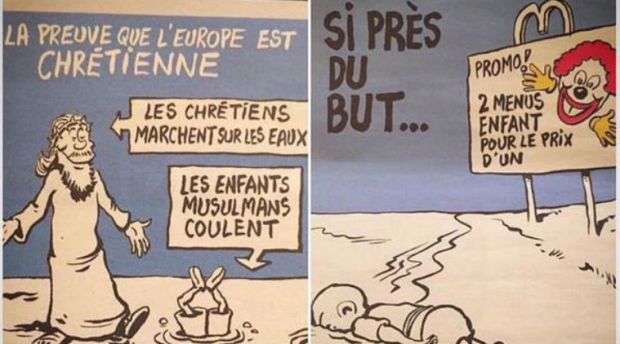When I first saw the image of Alan Kurdi, I couldn’t sleep that day. I didn’t have the strength to see it again. I’m a mother of a toddler boy almost the same age as Alan Kurdi. I just can’t imagine his final moments. Even as I’m writing this, I feel a lump in my throat. I hate war!! I hate it!!
When I first saw these two cartoons from Charlie Hebdo, I really didn’t know what they actually meant. Still I didn’t feel good to see the little one there again.
Cartoon 1:
Title: The proof that Europe is Christian
“Christians walk on water… Muslim kids sink.”
Cartoon 2:
Title: So close to his goal
“Two Menus Of Children For The Price Of One”. (The clown looks similar to McDonald’s Ronald)

Source: The Indian Express
Later I read this:
Maajid Nawaz, founder of the think-tank Quilliam defended the magazine’s cartoon: “Taste is always in the eye of the beholder. But these cartoons are a damning indictment on our anti-refugee sentiment,” he wrote on Facebook. “The McDonald’s image is a searing critique of heartless European consumerism in the face of one of the worst human tragedies of our times.
“The image about Christians walking on water while Muslims drown is (so obviously) critiquing hypocritical European Christian “love”.
Source: www.independent.co.uk
But the latest cartoon is totally insensitive and in very bad taste. This has nothing positive in it. It was based on the recent Cologne Sexual assaults. The moment I read the translated text, I started hating it. Why do you want to put the innocent child there?
“What would have happened to little Alan if he grew up?” “A groper of women in Germany.”

Source: cnn
There are lot of articles telling Charlie Hebdo didn’t mean it and people like me are oversensitive and are unable to grasp the satire. Whatever! I don’t like Charlie Hebdo!!



